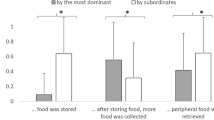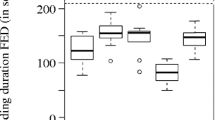Abstract
The feeding behavior of 16 adult female rhesus monkeys living in three captive social groups was observed. Estimates of relative food intake, feeding rate, and location of feeding in relation to food sources were compared between females of different dominance ranks. Higher-ranking females had greater access to feeding sites and were supplanted or threatened less frequently while feeding than subordinates. However, no consistent differences in estimates of total intake were found between females of high and females of low rank. The effects of dominance on feeding behavior were most pronounced in the group receiving the least food relative to estimates of overall group nutritional requirements. Higher-ranking females, both over the long term and during the study period, tended to produce more surviving offspring. The effects of dominance on reproductive performance appeared to be less related to food intake than to competitive and aggressive interactions, potentially resulting in higher levels of stress for subordinates.
Similar content being viewed by others
References
Abbott, D. H. (1984) Behavioral and physiological suppression of feritility in subordinate marmoset monkeys.Am. J. Primatol. 6: 169–186.
Abbott, D. H., Keverne, E. B., Moore, G. E., and Yodyingyuad, U. (1986) Social suppression of reproduction in subordinate talapoin monkeys,Miopithecus talapoin. In Else, J. G., and Lee, P. C. (eds.)Primate Ontogeny, Cognition and Social Behavior, Cambridge University Press, Cambridge, pp. 329–341.
Altmann, J. (1974). Observational study of behaviour: Sampling methods,Behaviour 49:227–265.
Altmann, J. (1980).Baboon Mothers and Infants, Princeton University Press, Princeton, N.J.
Barton, R. (1990). Peeding, reproduction and social organization in female olive baboons (Papio anubis). In de Mello, M. T., Whiten, A., and Byrne, R. W. (eds.),Baboons: Behavior and Ecology, University of Brasilia Press, Brasilia, pp. 29–37.
Berman, C. M. (1988). Maternal condition and offspring sex ratio in a group of free ranging rheusus monkeys.Am. J. Primatol. 7: 49–81.
Brennan, J., and Anderson, J. R. (1988). Varying responses to feeding competition in a group of rhesus monkeys (Macaca mulatta).Primates 29(3): 353–360.
Bowman, J. (1991).Life History Growth and Dental Development: A Study Using Captive Rhesus Macaques, Ph.D. thesis, University of Cambridge, Cambridge.
Bowman, L. A., Dilley, S. R., and Keverne, E. B. (1978). Suppression of oestrogen-induced LH surge by social subordination in talapoin monkeys.Nature 275: 56–58.
Cheney, D. L., Lee, P. C., and Seyfarth, R. M. (1981). Behavioural correlates of non-random mortality among free-ranging female vervet monkeys.Behav. Ecol. Sociobiol. 9: 153–161.
Cheney, D. L., Seyfarth, R. M., Andelman, S., and Lee, P. C. (1988). Reproductive success in vervet monkeys. In Clutton-Brock, T. H. (ed.),Reproductive Success, Univesity of Chicago Press, Chicago, pp. 384–402.
Coelho, A. M. (1974). Socio-bioenergetics and sexual dimorphism in primates.Primates 15: 263–269.
Datta, S. (1988). The acquisition of dominance among free-ranging rheusus monkey siblings.Anim. Behav. 36: 754–722.
Demment, M. W. (1983). Feeding ecology and the evolution of body size of baboons,Afr. J. Ecol. 21: 219–233.
Dittus, W. P. J. (1979). The evolution of behaviours regulating density and age-specific sex ratios in a primate population.Behaviour 69: 265–303.
Dunbar, R. I. M. (1980). Determinants and evolutionary consequences of dominance among female gelade baboons.Behav. Ecol. Sociobiol. 7: 253–265.
Dunbar, R. I. M. (1989). Reproductive strategies of female gelada baboons. In Rassa, A. E., Vogel, C., and Voland, E. (eds.),The Sociobiology of Sexual and Reproductive Strategies, Chapman & Hall, London, pp. 74–92.
Dunbar, R. I. M. (1990). Environmental and social determinants of fecundity in primates. In Landers, J., and Reynolds, V. (eds.)Fertility and Resources, Cambridge University Press, Cambridge, pp. 5–17.
Dunbar, R. I. M., and Dunbar, P. (1988). Maternal time budgets of gelada beboons.Anim. Behav. 36: 970–980.
Fa, J. E. (1984). Structure and dynamics of the Barbary macaque population in Gibralters. In Fa, F. E. (ed.),The Barbary Macaque—A Case Study in Conservation, Plenum Press, London, pp. 263–306.
Fairbanks, L. A., and McGuire, M. T. (1984) Determinants of fecundity and reproductive success in captive vervet monkeys.Am. J. Primatol. 7: 27–38.
Fairbanks, L. A., and McGuire, M. T. (1986). Age, reproductive value and dominance related behaviour in vervet monkey females: Cross-generational influences on social relationships and reproduction.Anim. Behav. 34: 1710–1721.
Gomendio, M. (1989). Suckling behavior and fertility in rhesus macaques.J. Zool. (London) 217: 449–467.
Gomendio, M. (1990). The influence of maternal rank and infant sex on maternal investment trends in macaques: Birth sex ratios, inter-birth intervals and suckling patterns.Behav. Ecol. Sociobiol. 27: 365–375.
Gomendio, M., Clutton-Brock, T. H., Albon, S. D., Guinness, F. E. and Simpson, M. J. A. (1990). Mammalian sex ratios and variations in the costs of rearing sons and daughters.Nature 343: 261–263.
Gouzoules, H., Gouzoules, S., and Fedigan, L. (1982). Behavioural dominance and reproductive success in female Japanese monkeys (Macaca fuscata).Anim. Behav. 30: 1138–1151.
Harcourt, A. H. (1987). Dominance and fertility among female primates.J. Zool. (London) 213: 471–487.
Hinde, R. A. (1983).Primate Social Relationships, Blackwell, Oxford.
Janson, C. H. (1985). Aggressive competition and individual food consumption in wild brown capuchin monkeys (Cebus apella).Behav. Ecol. Sociobiol. 18: 125–138.
Lee, P. C. (1984). Ecological influences on the development of vervet monkeys.Behaviour 91: 245–262.
Lee, P. C. (1987). Nutrition, fertility and maternal investment in primates.J. Zool. (London) 213: 409–422.
Loy, J. (1988). Effects of supplementary feeding on maturation and fertility. In Fa, J. E., and Southwich, C. H. (eds.),Ecology and Behavior of Food-Enhanced Primate Groups, Alan R. Liss, New York, pp. 153–166.
Martin, R. D. (1984) Scaling effects and adaptive strategies in mammalian lactation.Symp. Zool. Soc. Lond. 51: 87–117.
Mori, A. (1979). Analysis of population changes by measurement of body weight in the Koshima troop of Japanese monkeys.Primates 20: 371–397.
Paul, A., and Kuester, J. (1988). Life history patterns of semifree-ranging Barbary macaques (Macaca sylvanus) at Affenberg Salem. In Fa, J. E., and Southwick, C. H. (eds.),Ecology and Behaviour of Food-Enhanced Primate Groups. Alan R. Liss, New York, pp. 199–228.
Peters, R. H. (1983)The Ecological Implications of Body Size, Cambridge University Press, Cambridge.
Robinson, J. G. (1981). Spatial structure in foraging groups of wedged-capped capuchin monkeysCebus nigrivattatus.Anim. Behav. 29: 1036–1056.
Silk, J. B. (1988). Social mechanisms of population regulation in a captive group of bonnet macaques (Macaca radiata).Am. J. Primatol. 14: 111–124.
Simpson, A. E., and Simpson, M. J. A. (1985). Short-term consequences of different breeding histories for captive rhesus macaque mothers and young.Behav. Ecol. Sociobiol. 18: 83–89.
Simpson, M. J. A., Simpson, A. E., Hooley, J., and Zunz, M. (1981). Infant related influences on birth intervals in rhesus monkeys.Nature 290: 49–51.
Strum, S. C., and Western, J. D. (1982). Variations in fecundity with age and environment on olive baboons (Papio anubis).Am. J. Primatol. 3: 61–76.
Sugiyama, Y., and Ohsawa, H. (1982). Population dynamics of Japanese monkeys with special reference to the effects of artificial feeding.Folia Primatol. 39: 238–263.
van Noordwijk, M. A., and van Schaik, C. P. (1987). Competition among female long-tailed macaques (Macaca fasicularis).Anim. Behav. 35: 577–589.
Wasser, S. K. (1983). Reproductive competition and cooperation among female yellow baboons. In Wasser, S. K. (ed.),Social Behavior of Female Vertebrates, Academic Press, New York, pp. 349–390.
Wasser, S. K., and Barash, D. P. (1983). Reproductive suppression among female mammals: Implications for biomedicine and sexual selection theory.Quart. Rev. Biol. 58: 513–538.
Wasser, S. K., and Starling, A. K. (1986). Reproductive competition among female yellow baboons. In Else, J. G., and Lee, P. C. (eds),Primate Ontogeny, Cognition and Social Behaviour, Cambridge University Press, Cambridge, pp. 343–354.
Whitten, P. L. (1983). Diet and dominance among female vervet monkeys (Cercopithecus aethiops).Am. J. Primatol. 5: 139–159.
Wolfe, L. D. (1984). Female rank and reproductive success among Arashiyama B Japanese macaques (Macaca fuscata).Int. J. Primatol. 5: 133–143.
Wrangham, R. W. (1981). Drinking competition in vervet monkeys,Anim. Behav. 29: 904–910.
Author information
Authors and Affiliations
Rights and permissions
About this article
Cite this article
Deutsch, J.C., Lee, P.C. Dominance and feeding competition in captive rhesus monkeys. International Journal of Primatology 12, 615–628 (1991). https://doi.org/10.1007/BF02547673
Received:
Revised:
Issue Date:
DOI: https://doi.org/10.1007/BF02547673




